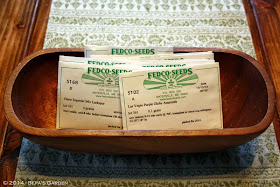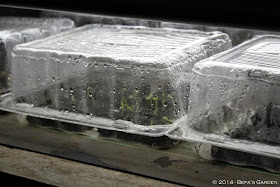This is turning out to be a very busy year!
Managing both the school garden and our garden at home hasn't left me much time for posts, so here is a quick update on what's been happening in the gardens.
 |
| Sweet basil waiting to be planted. |
The greenhouse is starting to empty, but still has several trays of plants waiting to go into the garden.
Most of the plants went into the school garden but there are still more flowers, herbs and a few vegetable seedlings that still need to get planted.
 |
| Drunken Woman Fringed Head Lettuce - almost ready to be picked! |
 | ||
| Another tray of lettuce, still in the 3/4" soil blocks! |
 | ||
| A tray of tomatoes, lemon balm and mint. |
This year I started several varieties of flowers to plant a cutting garden.
I started zinnias, calendula, dahlia, ageratum, amaranth, morning glory and lots of sunflowers.
 |
| Ageratum - Dondo Blue. |
 |
| Calendula - Mixed. |
I also started several varieties of herbs to create a medicinal herb garden. The plan is to grow my own organic herbs for salves, teas and tinctures. I started lemon grass, several different varieties of basil, rosemary, thyme, sage, chamomile, cayenne peppers, lemon balm, evening primrose, mint, marshmallow, licorice and peppermint.
The fence is already up, but the beds still need to be turned before I can get the seedlings in the ground.
 | |
| Lemon Grass |
 |
| Sage |
 |
| Holy Basil (Tulsi) |
 |
| Lemon Balm |
 |
| Rosemary |
 |
| Evening Primrose |
Some new varieties that I am trying for the first time this year are rhubarb and pop corn.
I purchased seeds from a supplier in Vermont and am excited to see what kind of results I get.
 |
| Rhubarb seedling. |
 |
| A tray of pop corn, started in soil blocks so the seeds wouldn't get eaten in the garden. |
I am always amazed by how well the plants grow in soil blocks. Using them has really cut down on the cost of plastic starting trays and pots.
The kale, lettuce and greens that I planted last fall have all started to go to seed. I am just waiting for the pods to turn brown so I can harvest the seed for next season.
 |
| Kale, lettuce and greens going to seed. |
 |
| Seed pods on the Ruby Streak - greens |
At the school garden, we added more beds, increasing the growing area to 1,200 square feet!
We also put up a fence to keep the deer out after seeing signs of them eating the greens last fall!
In a couple weeks we will be putting up a tool storage shed, building cold-frames and building one of my greenhouses so we can start seedlings right in the garden!
Most of the beds have already been planted and the beans we put in last week are just starting to emerge!
That's what's been going on in the gardens this spring.
While I wish I had more time for more posts, I am really enjoying the time spent working out in the gardens. Hopefully once everything is planted, and things settle down a bit, I can find time to share my results with growing the new varieties.
~Rob~









































